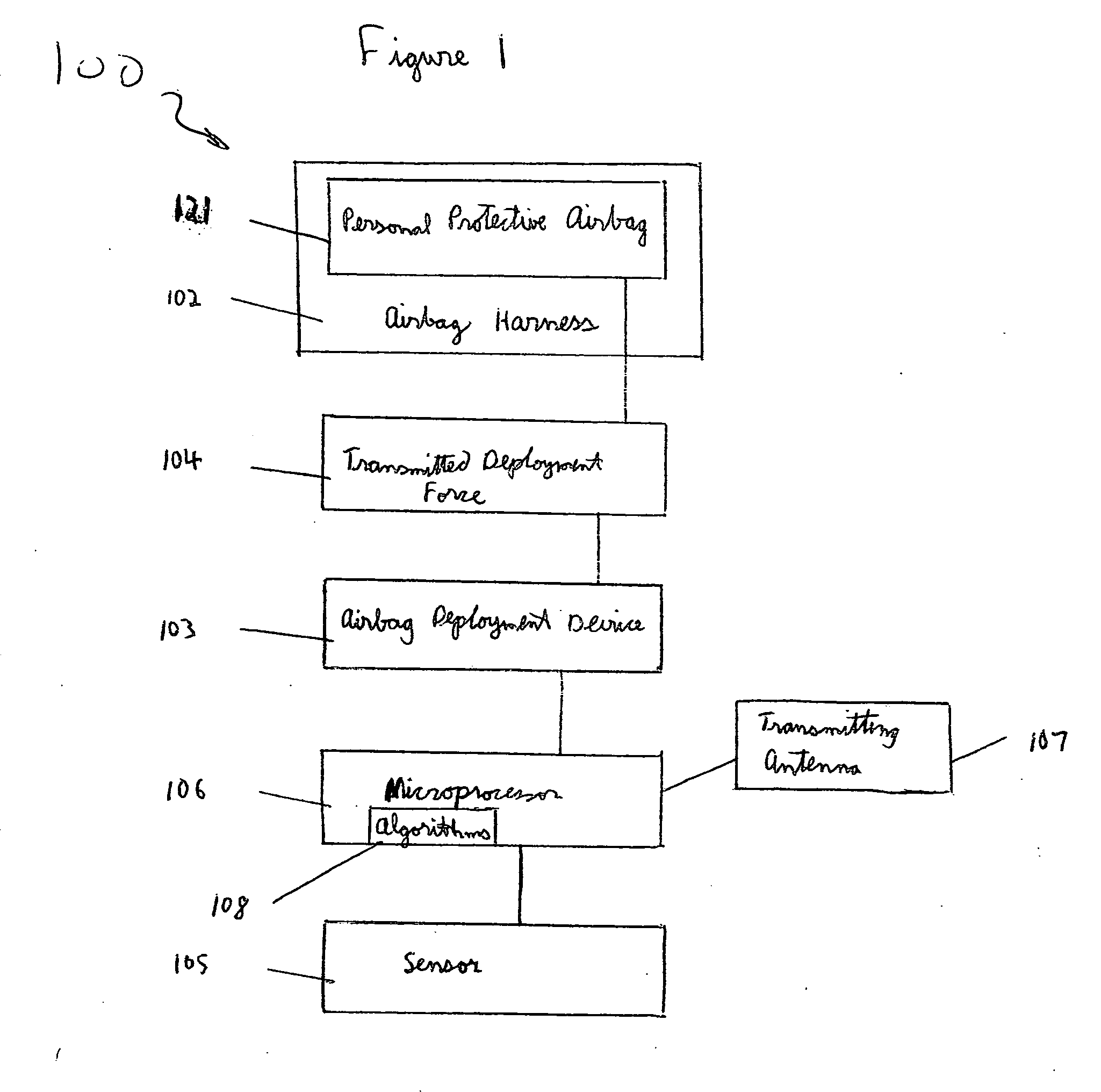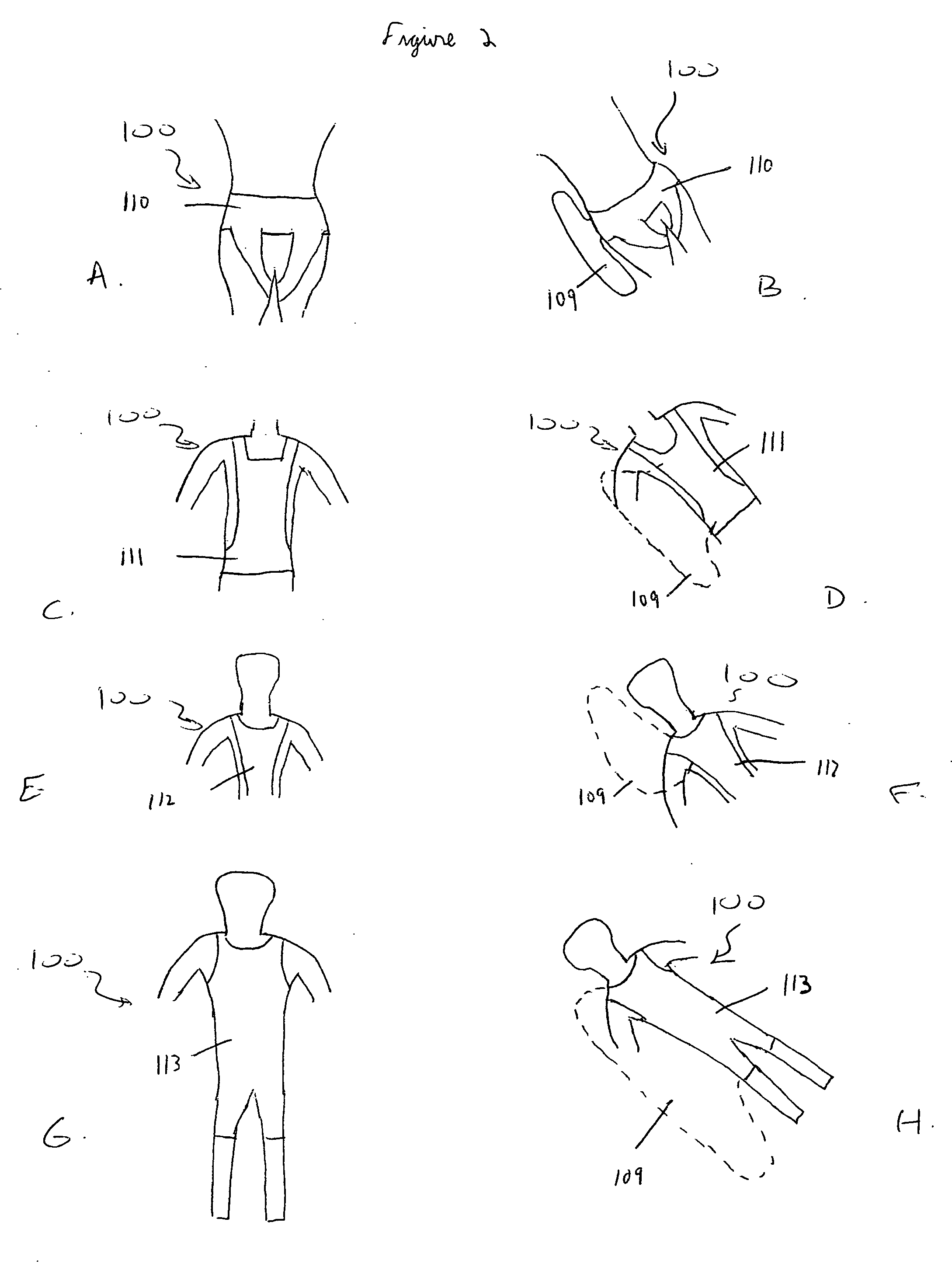[0009] The present invention relates to
injury prevention, for example hip fractures, in people prone to falls, because, for example, of advanced age or
movement disorders. In one embodiment, the present invention is an
inflatable airbag that is activated when a sensor detects that the wearer of the device is falling, but that is sufficiently light weight and easily worn to allow the wearer to have a normal degree of mobility and thereby not impede the wearer's normal activities. Additionally, the device can protect a wearer in a sitting or
prone position, as encountered in a
wheelchair or
bed. One object of the invention is to deploy the
airbag in the direction the user is falling by linking the direction of deployment to, for example, an
accelerometer's measured direction of fall.
[0010] Generally, the present invention includes a belt, harness, or other article of clothing, an airbag enclosed within the article of clothing, a sensor, a manual release device, and a
cartridge of a compressed substance that when released rapidly fills the airbag with a gas and causes deployment of the airbag, such that the wearer falls on the airbag instead of the ground. The airbag is packed within the belt or harness and fastened in place. The
fastener is disengaged by activation of the device and airbag inflation, which allows
airbag deployment. The device can also be designed to rapidly
deflate once the wearer has been gradually decelerated during the fall.
[0012] In one aspect, the invention relates to a personal protection device including an article adapted for wearing by an individual, an
inflatable airbag at least partially disposed within the article, a deployment mechanism disposed on at least one of the article and the airbag, an inflation mechanism disposed on at least one of the article and the airbag for inflating the airbag, and a mechanism for automatically deflating the airbag. The deployment mechanism deploys the airbag in response to one or more signals generated based on a status of the individual and the airbag protects the individual from injury. The airbag can be automatically deflated after at least one of an
impact, a predetermined time period, and / or a
changed status of the individual, for example, when the individual becomes substantially motionless. The device can be manually activated by a wearer if they are about to fall and can include an on / off switch to arm / disarm the device as necessary.
[0013] In another aspect, the invention relates to a personal protection device including an article adapted for wearing by an individual, an
inflatable airbag at least partially disposed within the article, a deployment mechanism disposed on at least one of the article and the airbag, and an inflation mechanism disposed on at least one of the article and the airbag for inflating the airbag. The deployment mechanism deploys the airbag in response to one or more signals generated based on a status of the individual and the airbag protects the individual from injury. In one embodiment, the
signal(s) is generated by a three-axis
accelerometer when the individual falls. Additionally or alternatively, the
signal(s) can be generated by an
inclinometer, an electro-
mechanical sensor, an electromagnetic switch, or an
infrared /
laser measurement device.
[0015] In another aspect, the invention relates to a personal protection device including an article adapted for wearing by an individual, an inflatable airbag at least partially disposed within the article, a deployment mechanism disposed on at least one of the article and the airbag, an inflation mechanism disposed on at least one of the article and the airbag for inflating the airbag, and electronic circuitry. The deployment mechanism deploys the airbag in response to a signal generated based on a status of the individual and the airbag protects the individual from injury. The electronic circuitry includes a sensor, a
microprocessor in electrical communication with the sensor, and a set of instructions (e.g., a
software program) stored within the
microprocessor. The sensor sends the signal to the processor in response to an event and the set of instructions determines a response based on the signal. In one embodiment, more than one sensor can be used to send signals to the
microprocessor, and the instructions stored within the microprocessor can determine a response based on multiple signals. The set of instructions can determine when and in which direction to deploy the airbag.
 Login to View More
Login to View More  Login to View More
Login to View More 


